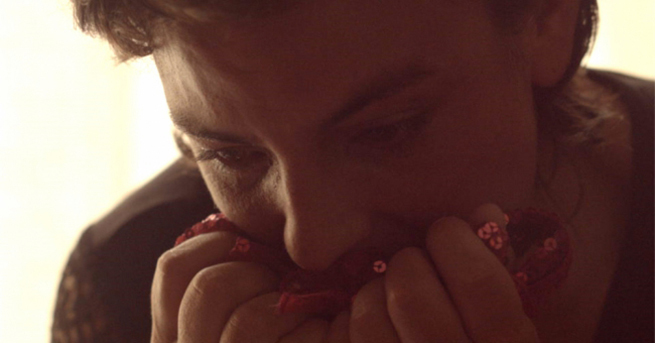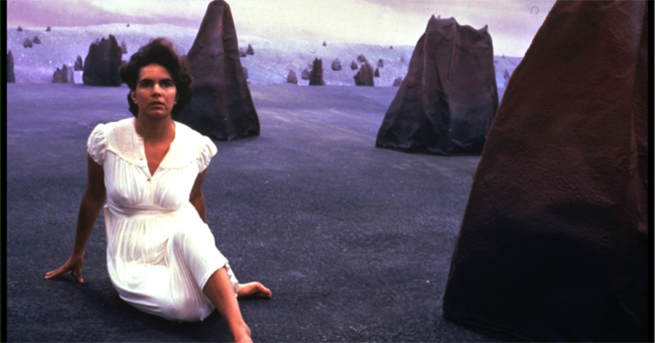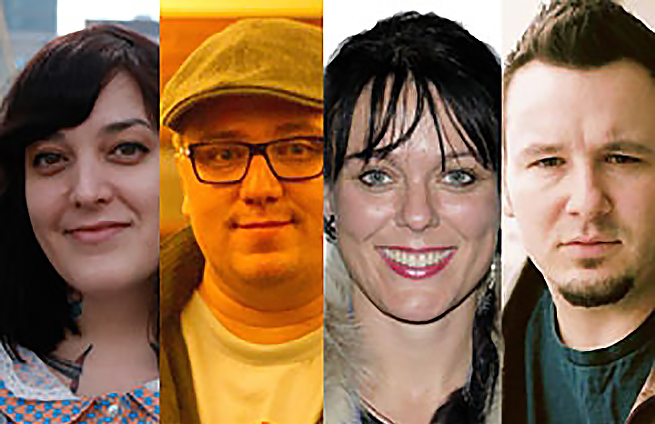
Now we’re at a point where people from Indigenous Nations are telling their stories…They have no shackles, they can make any kind of film that they want.
The 2014 imagineNATIVE Film + Media Arts Festival is celebrating its 15th anniversary of showcasing Indigenous cinema and media arts. MUSKRAT Magazine Staff Writer Jamaias DaCosta had the opportunity to sit down with the festival’s Executive Director, Jason Ryle to discuss the past, present, and what the future might hold for Indigenous filmmaking and for imagineNATIVE.

MM: As imagineNATIVE prepares to celebrate its 15th anniversary, what are you most excited about for this year’s festival?
JR: This is always so hard to decide, it’s kind of like trying to pick your favourite child. We do have a handful of special projects that we commissioned or partnered on for the 15th anniversary. One of them is a project [called Storytellers Screening], and in a lot of ways it’s really emblematic of what we try to do at imagineNATIVE in terms of looking at new and innovative ways of presenting Indigenous perspectives and stories.
Storytellers Screening pairs artists—one author and one filmmaker—who have each collaborated on a special presentation. The author has written a new short story, especially for this event, and has worked in collaboration with the filmmaker, who is creating a video work that will play simultaneously while the author is reading their story. So the idea is to really transcend media and stage and screen and really kind of focus storytelling in a different way.
I selected two teams, four different artists: the first one is Maria Campbell, who of course is legendary and we’re very excited to be working with her, and she is paired with Shane Belcourt, a really up and coming filmmaker. And the other team is Joseph Boyden (author of The Orenda) paired with Terril Calder, who is just an incredible stop-motion animator with an unbelievable body of work. We really wanted it to be focused on this idea of mixed–media looking at different ways of collaboration, but also all of these artists come from a Métis or mixed Indigenous heritage, which adds another layer that’s really interesting.
The other thing that’s really exciting to me for this year is our closing night screening, which is also one of our 15th anniversary events. It’s the Embargo Collective II, and for our 10th Anniversary back in 2009 we staged the first Embargo Collective, so this is the second iteration of that. Last year we brought together five female Canadian Indigenous filmmakers, all familiar with each other’s work in some way—because they are all either mid-career or emerging filmmakers—and they spent a week together during the festival. We commissioned each one of these five filmmakers to create a new short film for this year’s festival, and that is what the closing night gala is going to be, a presentation of those works.
The process is really important though; it was about passing on and sharing knowledge. For both Embargo’s that we’ve done, one of the baselines of it has been pushing the creative boundaries of each of the artists, perhaps sometimes into areas they’re not comfortable with, but the goal is to push them into creative new areas. So as a collective, each of these filmmakers came up with obstructions or challenges for each other. The first Embargo was incredibly successful for us, one of them went on to win the Genie Award for Best Live Action Short Film, another was named to [Toronto International Film Festival’s] Top Ten Short Films that year. I’m really excited to see what the outcome is. It’s a project that is being undertaken by Executive Producer and incredible filmmaker in her own right, Danis Goulet, and I haven’t seen any of the films. I want to attend this screening completely cold so I won’t see them until everyone sees them on Closing Night.

MM: What are some of the highlights of imagineNATIVE over the last 15 years, or since you’ve been involved in 2002?
JR: I’ve been the Executive Director since 2010; I’ve been on the board for most of the time prior to that. My involvement has been mostly as a volunteer. I have been a programmer with the festival since 2002, so I’ve really had the privilege of screening probably thousands of works with the programming team.
We program on a consensus basis, and every year it’s the most amazing experience, but it’s also easily the hardest experience. Over the past 12 years of my time, it’s been incredible to watch imagineNATIVE grow alongside with the industry. It’s been amazing to see the growth and diversity of creative expression of the films in general, as well as the artistic development of artists.
Every year we do see someone’s life being changed or significantly touched in some way because of their time at the festival. It could be an artist who’s coming from rural remote Australia and presenting their work for the first time in a festival environment, and what an incredible impact that might have on their life and their work.

MM: You mention the challenge of the selection process: how do you navigate that process? What are some of the things that you look for when selecting films for the festival?
JR: There is a general misconception out there that if a work isn’t selected for public presentation at imagineNATIVE or at any festival, that it is comment on the quality of the work. Almost always, it’s not. Sometimes your favourite doesn’t get selected, and again it’s on that consensual basis. It’s all about finding works that fit—so if you’re talking about a shorts program, you’re trying to put together a program based on a certain theme or curatorial focus. Every year we have special programs with only a limited number of slots. So in some ways, the really unfortunate nature of any festival is that you say no to artists that you love, whose work that you love. It’s a very emotional experience for us, as well as the artists.
We have an artistic policy that we’ve been following, and it has a number of different points, but programming is ultimately a subjective process for anyone involved. We have guidelines with our artistic policy that look for work that is innovative, challenging, that pushes form and media, and looking for work that is really culturally and artistically significant that touches on common themes or issues that are part of the Indigenous zeitgeist story now.
But really having said all that, it’s a challenging process because we really try to keep at the forefront our audiences. Our audiences are incredibly diverse and we want to make sure that we have something for everyone as best as possible based on what’s submitted. But also, we try as best as possible to get a geographic, linguistic, Indigenous-ethnic diversity and representation from across Canada. That can be difficult of course, because again, it’s based on what is submitted—but those are some of our goals.

MM: How is Indigenous cinema different from mainstream cinema, or is there a difference at all?
JR: You can answer in so many different ways – certainly people over the course of the last few decades have pointed to certain aesthetic or creative mechanisms that are used in Indigenous films. Non-conventional, non-Hollywood structures, like a non-three act structure for a screenplay; incorporating what the literary world calls magic realism but others just call every day life, it could be things like elasticity of flexibility in time.
But what I really point to more when we talk about Indigenous cinema, is that we’re talking about a larger world cinema, it’s not isolated it’s part of a larger body of work that exists internationally. We’re still in the process of talking about the first time this type of film was made or played here, or the first time this film achieved that; so we’re still doing a lot of work in terms of raising awareness for Indigenous cinema. Especially for Indigenous Nations in North America, you’re talking about people whose identity has been ascribed by a hundred years of Hollywood filmmaking.
Now we’re at a point where people from Indigenous Nations are telling their stories, stories that they want to tell. They have no shackles, they can make any kind of film that they want.
I think part of Indigenous cinema will always have stories and we should always have stories about things like residential schools and the effects of colonization, the struggle for our land or our rights. But at the same time you have love stories, or science fiction stories, or experimental stories about anything, and it really speaks to the strength of our Nations and the artistry of our artists, but it also speaks to an appetite from larger audiences for this work.

MM: Can you describe the evolution of imagineNATIVE and where you see it going in the future?
JR: The festival has grown, attendance has grown, revenues have grown, what we’re able to do has expanded. We are a presenting organization and we have a lot of opportunities to do different types of work in terms of more development type of things, and I think that’s where imagineNATIVE could potentially grow in the future. Similarly to the Sundance Film Festival model, where there is the Sundance Festival proper and then there’s the Sundance Institute—and they are really involved and interested in the professional development of the careers of filmmakers.
So that is something that we have been looking at, and we took our first dip in the water this past spring with our first professional development lab that was focused on dramatic feature film script development. We had four Canadian artists selected to take part in that lab, and that is something I’d like to look at expanding in the future, because there is certainly a need and a desire for these things, and I think that we are a good place to help develop and support that.

While we’re [in our 15th year], we do tip our hat to what came before, but really for us we are so excited to see how we can use this collective might of our history to propel us forward. I’m really excited about the next 15 years, and even beyond.

ImagineNATIVE Film + Media Arts Festival takes place from October 22-26, 2014. Screening and event information can be found on their website at www.imagineNATIVE.org
 Jason Ryle is a programmer, writer and filmmaker based in Toronto. Jason also sits on the Board of Directors for Vtape, one of Canada’s largest independent video distributors, and he was previously a programmer for the Native Cinema Showcase in Santa Fe, New Mexico. As an award-winning writer, Jason has written for the Smithsonian Institution and numerous publications throughout North America. He is also a script reader for The Harold Greenberg Fund, which provides financial aid to Canadian filmmakers.
Jason Ryle is a programmer, writer and filmmaker based in Toronto. Jason also sits on the Board of Directors for Vtape, one of Canada’s largest independent video distributors, and he was previously a programmer for the Native Cinema Showcase in Santa Fe, New Mexico. As an award-winning writer, Jason has written for the Smithsonian Institution and numerous publications throughout North America. He is also a script reader for The Harold Greenberg Fund, which provides financial aid to Canadian filmmakers.









